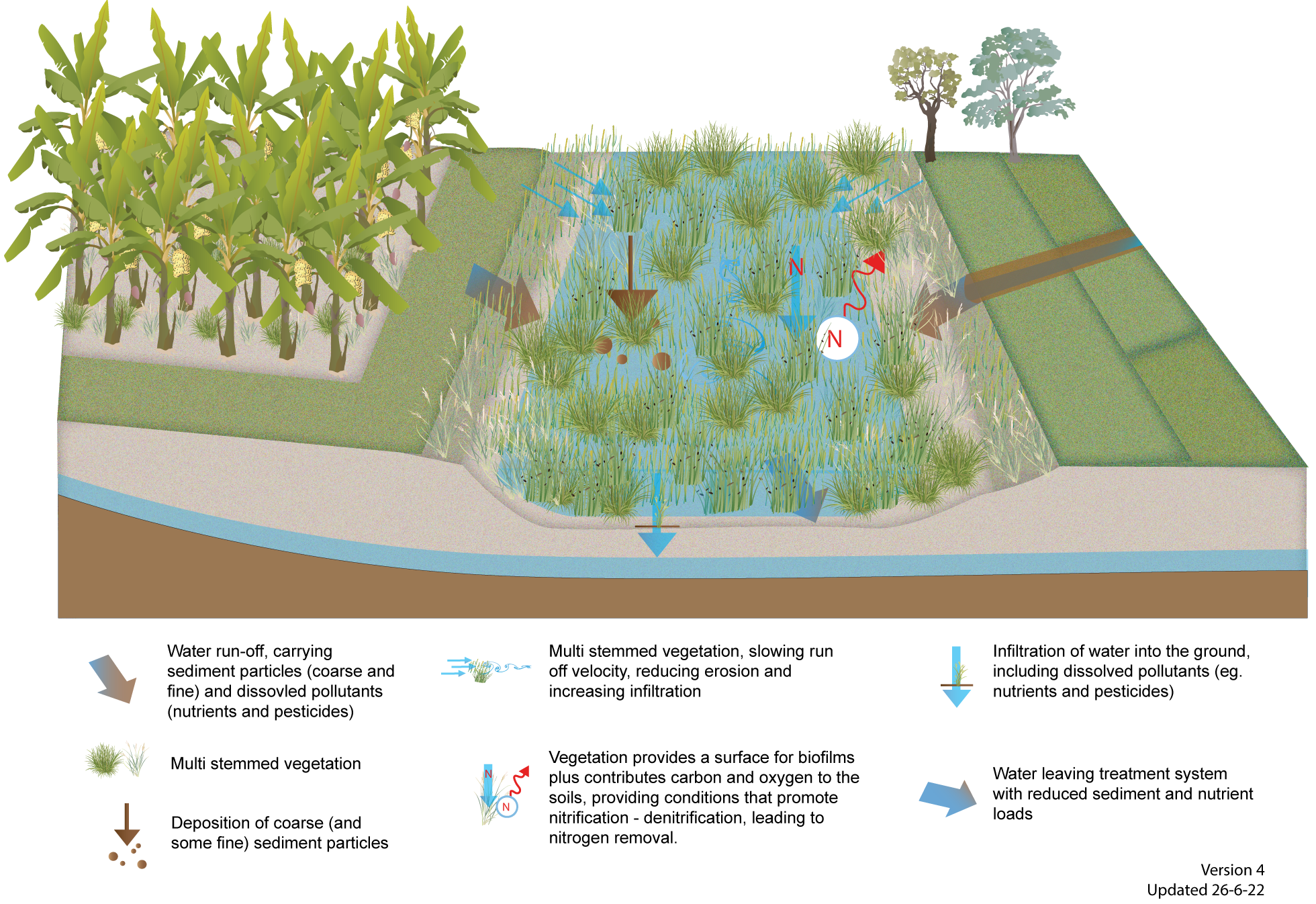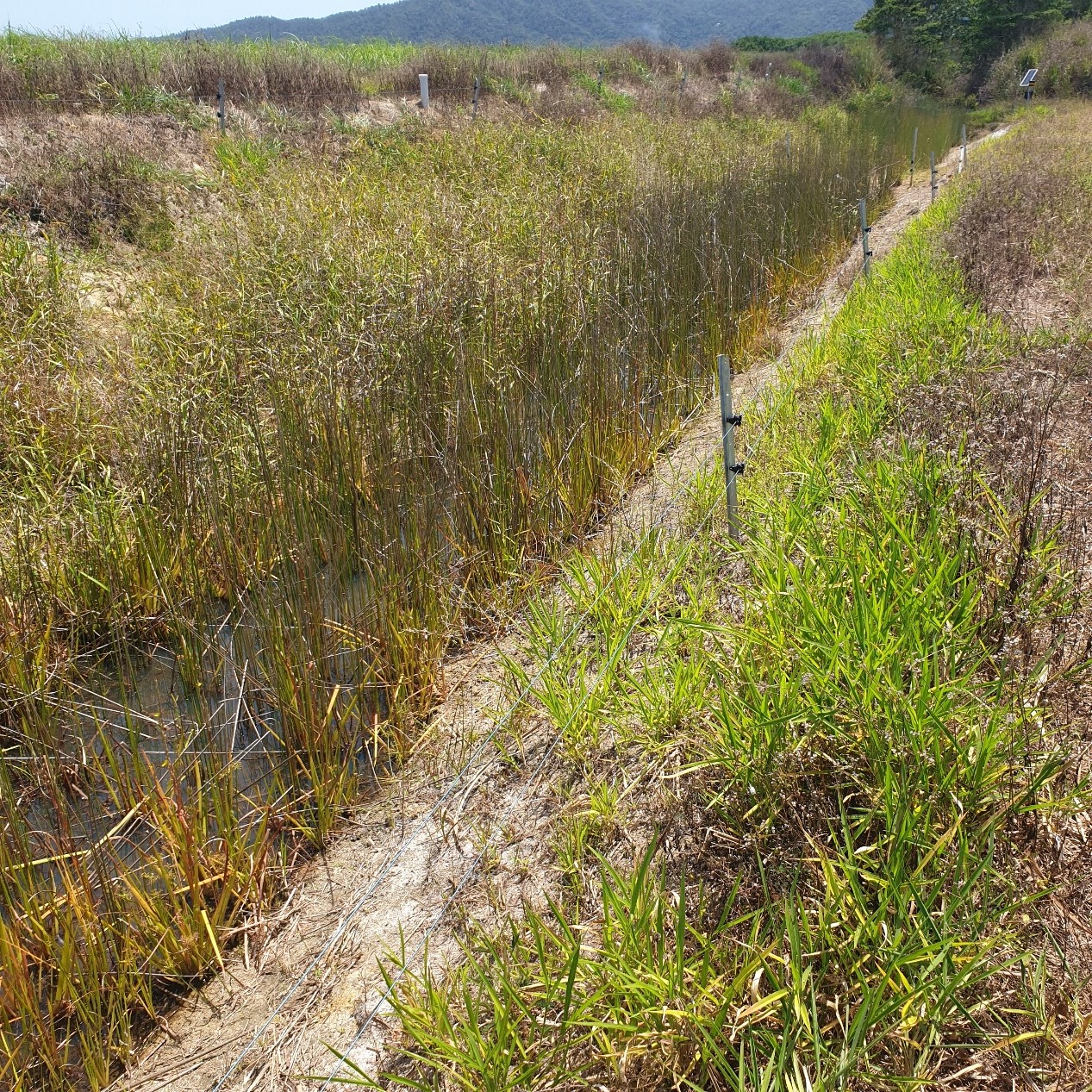|
|
Vegetated drainsVegetated drains — Construction and operationSelect from the tabs below ApprovalsLegislation and approvals may be required for the construction of a treatment system. Contact your local government before any construction is undertaken to understand requirements. For example:
ConstructionVegetated drains usually involve modifying or managing existing drains and therefore should require minimal, if any earthworks. New drains or significantly altered drains (i.e. to provide lateral benches) will require earthworks to flatten the batters or construct benches. Drains will generally be constructed at the same time as the farm or block is being established, involving earthworks. The earthworks should avoid disturbing acid sulfate soils and shallow bedrock. To minimise sediment loss, construction should occur in the dry season and groundcover established as soon as possible so soil is not left bare. Topsoil should be replaced in the drain and batters following construction to provide a suitable substrate for vegetation growth. EstablishmentVegetated drains need to be well vegetated using a mix of native grasses, sedges and rushes. Plants with a spreading/rhizomatous habit are ideal to stabilise the batters, while clumping reeds and sedges tend to grow taller and are better suited to the base of the drain[1]. Introduced pasture grass weeds such as hymenachne and paragrass can readily dominate drains and grow across the water surface. They can impact treatment performance if they restrict flow, causing water to stagnate. Weeds like these will need to be controlled in drains, prior to establishing desirable vegetation. The most cost-effective approach is to seed the system with a mix of native species, or if suitable vegetation exists nearby on farm, allow the vegetation to recruit or colonise naturally. Natural recruitment runs the risk of erosion, increased weediness and increased maintenance and may need to be supplemented with seed. Use local guidelines if they are available to assist with plant selection or contact your local Landcare or NRM group. Naturally vegetated systems such as waterways, wetlands and riparian zones are a good reference from which to create a species template. See plant guides. Irrigation and weed management may be needed until the vegetation is fully established. The risk of not achieving the desired vegetation density is poor treatment performance, potential for erosion and the colonisation of weeds. Therefore, it is important that the vegetation in the drain is established successfully. Establish vegetation cover before the wet season to avoid young plants drowning or being damaged during flood events. A vegetated drain can be constructed and established within a few months or it can take two to three years to establish vegetation depending on site conditions[3]. OperationCovered in maintenance (below) Monitoring and maintenanceEnsuring adequate, dense vegetation growth in most of the drain (or in nodes/sections of the drain) is the key maintenance objective[1]. Vegetated drains should be inspected every 6 months or after major rain events, to check vegetation cover is intact and ensure there is no erosion or sediment build-up. Typical maintenance will involve:
If farm best management practices are not adopted in the catchment, large amounts of sediment may be exported, quickly filling drains with sediment. This will require frequent sediment removal to maintain drain capacity and reduce treatment performance, therefore preventing soil loss through best management practices is a priority. Vegetated drains can be monitored to assess if they are effectively removing pollutants. Guidance on designing a monitoring program for assessing nitrogen removal by treatment wetlands and vegetated drains is provided in Monitoring guidelines to quantify nitrogen removal in vegetated water treatment systems. Lifepsan/replacement timeVegetated drains should last indefinitely if adequately maintained and farm best management practices adopted. DisclaimerIn addition to the standard disclaimer located at the bottom of the page, please note the content presented is based on published knowledge of treatment systems. Many of the treatment systems described have not been trialled in different regions or land uses in Queensland. The information will be updated as new trials are conducted and monitored. If you have any additional information on treatment systems or suggestions for additional technologies please contact us using the feedback link at the bottom of this page. References
Last updated: 24 May 2022 This page should be cited as: Department of Environment, Science and Innovation, Queensland (2022) Vegetated drains — Construction and operation, WetlandInfo website, accessed 8 May 2025. Available at: https://wetlandinfo.des.qld.gov.au/wetlands/management/treatment-systems/for-agriculture/treatment-sys-nav-page/vegetated-drains/construction-operation.html |

 — Department of the Environment, Tourism, Science and Innovation
— Department of the Environment, Tourism, Science and Innovation



